Bill.com Bundle
Who Really Owns Bill.com?
Uncover the intricate web of stakeholders behind the financial technology powerhouse, Bill.com. Understanding the Bill.com SWOT Analysis and its ownership structure is paramount for anyone looking to navigate the complexities of the fintech landscape. From its IPO debut to its current market position, the journey of Bill.com is a testament to the dynamic nature of business ownership.
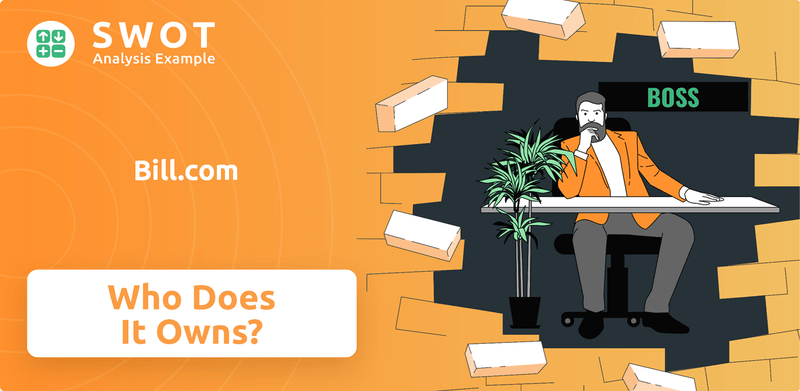
Delving into the details of Bill.com's ownership reveals crucial insights into its strategic direction and potential future. Knowing the Bill.com investors, including the major shareholders and the Bill.com parent company, is vital for assessing the company's long-term prospects. This exploration of Bill.com ownership will provide a comprehensive understanding of the company's history and the forces shaping its evolution.
Who Founded Bill.com?
The story of who owns Bill.com begins with its founder, René Lacerte, who launched the company in April 2006. Initially named Cashboard, Inc., the company quickly evolved into a significant player in the business payments sector. Lacerte's vision was to streamline financial operations for businesses, a goal that shaped the company's early direction and its focus on accounts payable and receivable.
Lacerte's background, including his experience as an auditor and his family's entrepreneurial history, played a crucial role in shaping Bill.com's mission. His previous venture, PayCycle, an online payroll solution, provided him with valuable insights into the needs of businesses. This experience helped him identify the potential for automating financial functions beyond payroll, which led to the development of Bill.com's core services.
Early financial backing was essential for Bill.com's growth. The company secured a seed round in 2006, followed by a Series A funding round in 2007, which brought in approximately $8.5 million. These initial investments from venture capital firms were critical in developing the accounts payable and receivable automation platform. While specific equity splits aren't available, Lacerte's role as CEO and board member highlights his significant influence from the beginning.
René Lacerte founded Bill.com in April 2006. He previously co-founded PayCycle.
Bill.com secured a seed round in 2006. A Series A funding round of approximately $8.5 million followed in 2007.
August Capital and DCM Ventures were among the early investors. These investments supported the development of the core platform.
Bill.com focused on automating accounts payable and receivable. This was a key element of its early strategy.
Lacerte's role as CEO and board member demonstrated his significant influence. His experience shaped the company's direction.
Early agreements often included vesting schedules and buy-sell clauses. These details are not publicly available.
Understanding the initial ownership structure of Bill.com is key to tracing its evolution. The early funding rounds and the involvement of venture capital firms set the stage for future growth and changes in the ownership landscape. While specific details about the equity distribution among the founders and early investors are not fully available in public records, the roles and influence of key individuals and firms are evident.
- Who owns Bill.com starts with René Lacerte, who founded the company.
- Early investors like August Capital and DCM Ventures played a crucial role.
- The initial focus was on automating accounts payable and receivable.
- The company's history includes multiple funding rounds to support growth, as discussed in the Growth Strategy of Bill.com.
Bill.com SWOT Analysis
- Complete SWOT Breakdown
- Fully Customizable
- Editable in Excel & Word
- Professional Formatting
- Investor-Ready Format
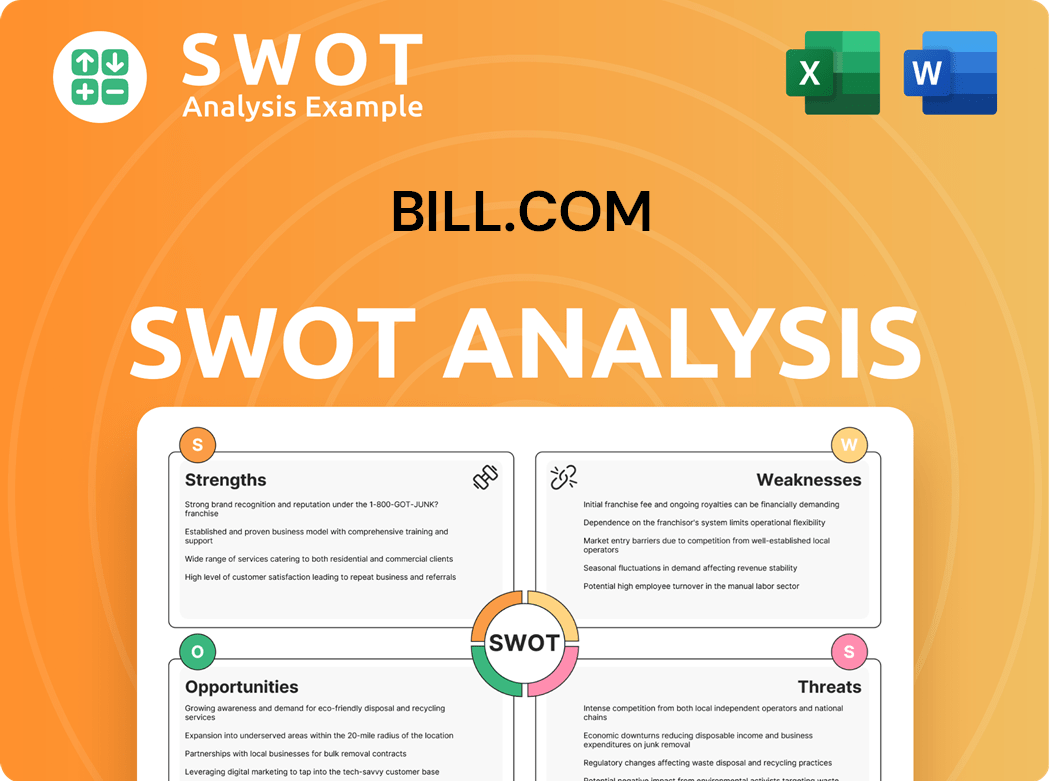
How Has Bill.com’s Ownership Changed Over Time?
The evolution of Bill.com ownership has been marked by significant milestones, starting with its Initial Public Offering (IPO) on December 12, 2019. The IPO, priced at $22.00 per share, raised approximately $216 million, setting an initial valuation around $1.6 billion. This transition from private venture capital to a public entity broadened the shareholder base significantly. Before the IPO, several funding rounds shaped the ownership landscape, with firms like Emergence Capital Partners and DCM Ventures playing key roles in early investments. A notable funding round, led by Franklin Templeton in April 2019, raised $88 million and pushed the valuation above $1 billion, including participation from Mastercard and Fidelity Investments Canada ULC. These early investments and the IPO have profoundly impacted the company's strategy and governance.
As of early 2025, the ownership structure of Bill.com is diverse. Institutional investors hold approximately 22.96% of the company's stock, while insiders own around 3.24%, and retail investors account for 27.97%. This distribution reflects a shift from the initial private funding rounds to a more dispersed ownership model. The IPO and subsequent market activities have played a crucial role in this diversification, introducing a variety of shareholders and influencing the company's strategic direction. The shift to a public company status has also increased transparency and regulatory oversight, affecting how the company operates and makes decisions.
| Ownership Event | Date | Impact |
|---|---|---|
| Initial Funding Rounds | Pre-IPO | Established early investor base, influenced initial strategic direction. |
| Franklin Templeton Funding Round | April 2019 | Raised $88 million, increased valuation over $1 billion. |
| IPO | December 12, 2019 | Raised $216 million, shifted ownership to public market, and set initial valuation at $1.6 billion. |
Major institutional shareholders, like The Vanguard Group Inc., BlackRock, Inc., and T. Rowe Price Associates Inc. /md/, hold substantial stakes in Bill.com. Vanguard Group Inc. holds 8,369,376 shares, or 8.12% of the company, according to recent data. BlackRock, Inc. held approximately 8.75 million shares, or 8.3% of the company, as of February 2023. Other key institutional investors include Temasek Holdings (Private) Limited, State Street Global Advisors, Inc., and UBS Asset Management AG. These investors often influence company strategy through their significant holdings and engagement with the board of directors. Understanding the Bill.com investors and their holdings provides insights into the company's financial backing and potential future directions. For a deeper dive into the company's origins, consider reading Brief History of Bill.com.
The ownership structure of Bill.com has evolved significantly since its IPO.
- Institutional investors hold a significant portion of the company's stock.
- The IPO was a pivotal event, shifting from private to public ownership.
- Early funding rounds and key investors have shaped the company's trajectory.
- Understanding the ownership structure is crucial for assessing the company's strategic direction.
Bill.com PESTLE Analysis
- Covers All 6 PESTLE Categories
- No Research Needed – Save Hours of Work
- Built by Experts, Trusted by Consultants
- Instant Download, Ready to Use
- 100% Editable, Fully Customizable
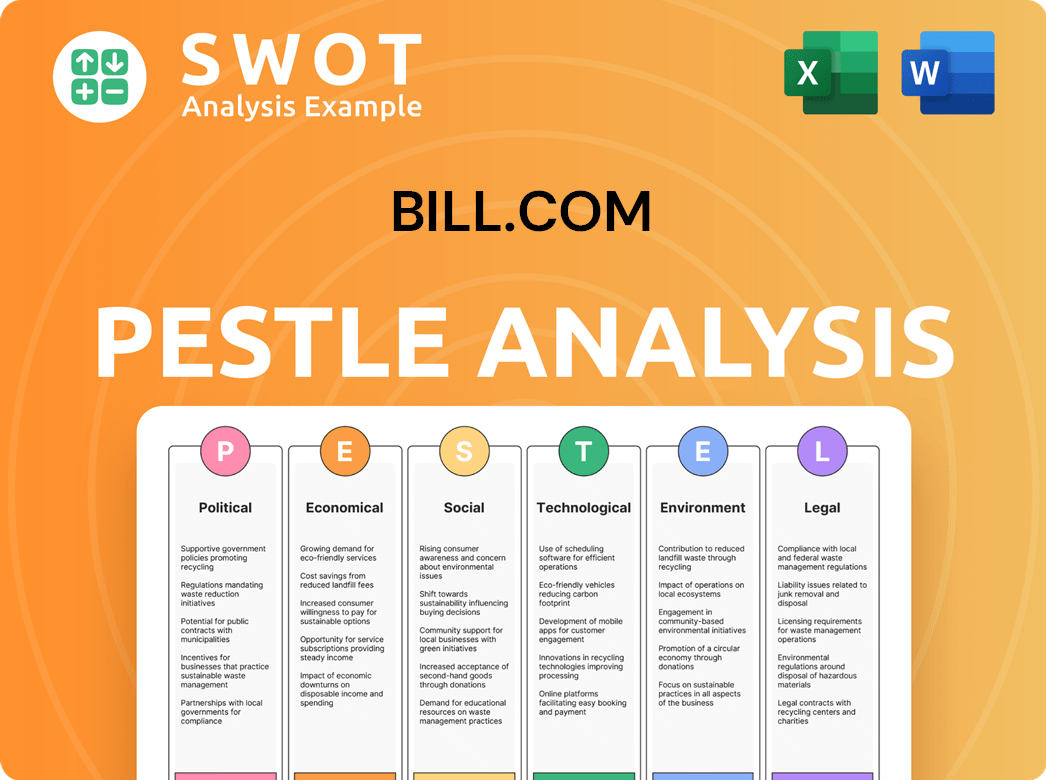
Who Sits on Bill.com’s Board?
The current board of directors at the company plays a significant role in its governance and strategic direction. René Lacerte, the Chief Executive Officer, is also a board member, a position he has held since the company's inception. Other board members include Aida Alvarez, Steven Cakebread, Steve Fisher, Keri Gohman, David Hornik, Brian Jacobs, Allie Kline, Allison Mnookin, Tina Chan Reich, Alison Wagonfeld, and Dan Wernikoff. Keri Gohman and Dan Wernikoff joined the board in January 2025.
Steve Fisher, a board member, also serves on the board of directors for Copart. He previously held executive leadership roles at Salesforce and eBay. This diverse board composition brings a wealth of experience from various sectors, contributing to the company's oversight and strategic planning. The presence of individuals with experience in technology and finance supports the company's growth and market position.
| Board Member | Role | Additional Information |
|---|---|---|
| René Lacerte | CEO and Board Member | Founder of the company |
| Aida Alvarez | Board Member | |
| Steven Cakebread | Board Member | |
| Steve Fisher | Board Member | Also on Copart's board, former executive at Salesforce and eBay |
| Keri Gohman | Board Member | Joined January 2025 |
| David Hornik | Board Member | |
| Brian Jacobs | Board Member | |
| Allie Kline | Board Member | |
| Allison Mnookin | Board Member | |
| Tina Chan Reich | Board Member | |
| Alison Wagonfeld | Board Member | |
| Dan Wernikoff | Board Member | Joined January 2025 |
In terms of voting structure, each share of common stock represents one vote. The company's Insider Trading Policy restricts employees, including named executive officers and board members, from pledging securities as collateral for a loan, unless approved by the General Counsel. There are no publicly disclosed details of dual-class shares, special voting rights, or golden shares that would grant outsized control beyond proportional shareholding. The company's ownership structure and governance practices are designed to ensure equitable treatment of all shareholders. For more information on the company's target market, you can read about it in this article: Target Market of Bill.com.
The board of directors is crucial for the company's strategic direction. Recent appointments in early 2025 reflect ongoing efforts to strengthen leadership.
- Voting Rights: One vote per share of common stock.
- Insider Trading Policy: Restrictions on pledging securities.
- Shareholder Focus: Aiming for equitable treatment of all shareholders.
- Institutional Investors: Major investors include Vanguard and BlackRock.
Bill.com Business Model Canvas
- Complete 9-Block Business Model Canvas
- Effortlessly Communicate Your Business Strategy
- Investor-Ready BMC Format
- 100% Editable and Customizable
- Clear and Structured Layout
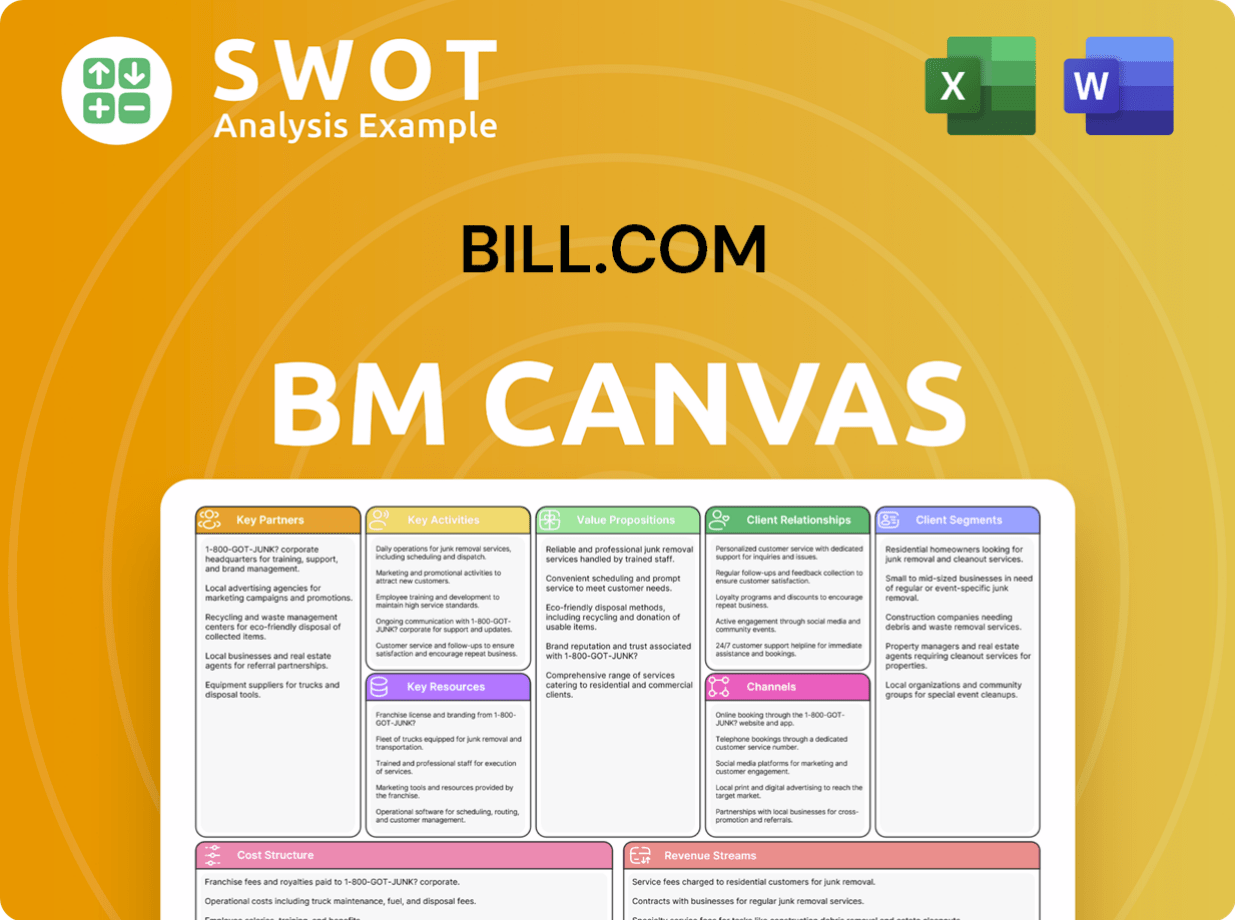
What Recent Changes Have Shaped Bill.com’s Ownership Landscape?
In the past few years, the ownership profile of Bill.com has seen significant shifts due to strategic financial moves. A key trend has been the company's share repurchase programs, reflecting efforts to manage capital and potentially boost shareholder value. In August 2024, a new program was authorized for $300.0 million, with approximately $100.0 million remaining as of March 31, 2025. During the nine months ended March 31, 2025, Bill.com repurchased 3,711,246 shares for $201.3 million. Furthermore, in December 2024, the board approved an additional $200.0 million share repurchase tied to the issuance of convertible senior notes, leading to the repurchase of 2,260,397 shares for approximately $200.0 million.
These share repurchases are part of a broader strategy that includes debt management and acquisitions. In December 2024, Bill.com completed a $1.4 billion offering of 0% Convertible Senior Notes due 2030, using proceeds to repurchase existing notes. Approximately $130.8 million was used to repurchase about $133.9 million of its outstanding 0% Convertible Senior Notes due 2025, and $408.6 million was used to repurchase approximately $451.5 million of its 0% Convertible Senior Notes due 2027. Additionally, the company has been actively involved in strategic acquisitions, including Divvy in June 2021 for $2.5 billion, Invoice2go in September 2021 for $625 million, and Finmark in November 2022, which has reshaped its business landscape. These moves impact the overall Bill.com ownership structure.
Leadership changes and industry trends also influence the Bill.com ownership landscape. In June 2025, Rohini Jain was appointed as Chief Financial Officer, and John Rettig's role as President was expanded, indicating a focus on strengthening the executive team. In May 2025, Mike Cieri joined as EVP, GM of Software Solutions. Simultaneously, industry trends show increasing institutional ownership. While founder dilution is a natural outcome of multiple funding rounds and an IPO, René Lacerte remains the CEO and a board member, ensuring continued founder influence. For more details on the company's history, you can read more about it here: 0.
Bill.com has been actively repurchasing shares. In August 2024, a $300.0 million share repurchase program was approved. As of March 31, 2025, $100.0 million remained available under this program. These actions demonstrate the company's commitment to managing its capital effectively.
In December 2024, Bill.com completed a $1.4 billion offering of 0% Convertible Senior Notes due 2030. A portion of the proceeds was used to repurchase existing notes. This strategic move aims to optimize the company's capital structure and manage its debt profile.
Recent appointments include Rohini Jain as CFO in June 2025, and the expansion of John Rettig's role as President. These changes signal the company’s focus on strengthening its executive leadership and strategic direction. Mike Cieri joined as EVP, GM of Software Solutions in May 2025.
Bill.com has expanded through strategic acquisitions, including Divvy, Invoice2go, and Finmark. These acquisitions support the company’s growth strategy and broaden its product offerings. These acquisitions are a key part of the Bill.com acquisition strategy.
Bill.com Porter's Five Forces Analysis
- Covers All 5 Competitive Forces in Detail
- Structured for Consultants, Students, and Founders
- 100% Editable in Microsoft Word & Excel
- Instant Digital Download – Use Immediately
- Compatible with Mac & PC – Fully Unlocked
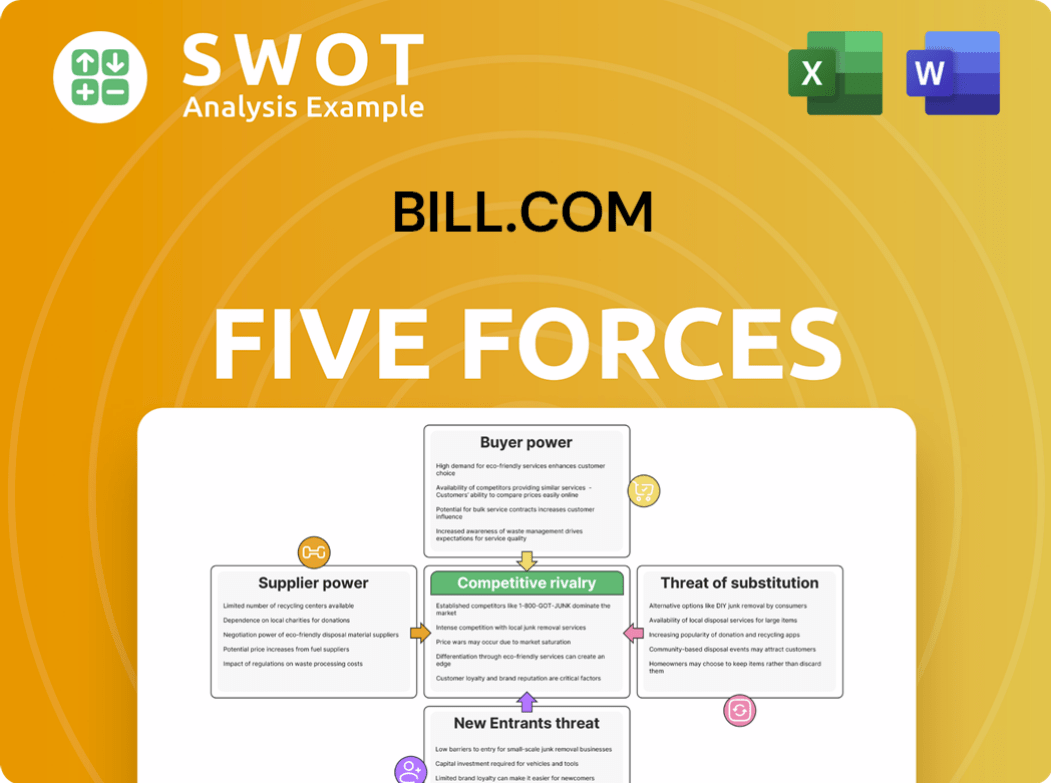
Related Blogs
- What are Mission Vision & Core Values of Bill.com Company?
- What is Competitive Landscape of Bill.com Company?
- What is Growth Strategy and Future Prospects of Bill.com Company?
- How Does Bill.com Company Work?
- What is Sales and Marketing Strategy of Bill.com Company?
- What is Brief History of Bill.com Company?
- What is Customer Demographics and Target Market of Bill.com Company?
Disclaimer
All information, articles, and product details provided on this website are for general informational and educational purposes only. We do not claim any ownership over, nor do we intend to infringe upon, any trademarks, copyrights, logos, brand names, or other intellectual property mentioned or depicted on this site. Such intellectual property remains the property of its respective owners, and any references here are made solely for identification or informational purposes, without implying any affiliation, endorsement, or partnership.
We make no representations or warranties, express or implied, regarding the accuracy, completeness, or suitability of any content or products presented. Nothing on this website should be construed as legal, tax, investment, financial, medical, or other professional advice. In addition, no part of this site—including articles or product references—constitutes a solicitation, recommendation, endorsement, advertisement, or offer to buy or sell any securities, franchises, or other financial instruments, particularly in jurisdictions where such activity would be unlawful.
All content is of a general nature and may not address the specific circumstances of any individual or entity. It is not a substitute for professional advice or services. Any actions you take based on the information provided here are strictly at your own risk. You accept full responsibility for any decisions or outcomes arising from your use of this website and agree to release us from any liability in connection with your use of, or reliance upon, the content or products found herein.